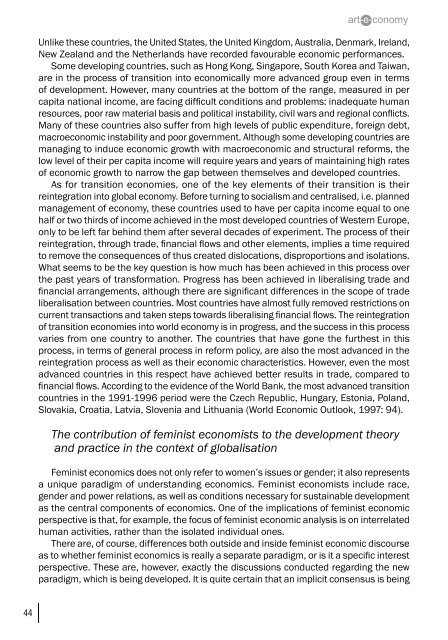art-e-conomy _ reader - marko stamenkovic
art-e-conomy _ reader - marko stamenkovic
art-e-conomy _ reader - marko stamenkovic
You also want an ePaper? Increase the reach of your titles
YUMPU automatically turns print PDFs into web optimized ePapers that Google loves.
44<br />
Unlike these countries, the United States, the United Kingdom, Australia, Denmark, Ireland,<br />
New Zealand and the Netherlands have recorded favourable economic performances.<br />
Some developing countries, such as Hong Kong, Singapore, South Korea and Taiwan,<br />
are in the process of transition into economically more advanced group even in terms<br />
of development. However, many countries at the bottom of the range, measured in per<br />
capita national income, are facing difficult conditions and problems: inadequate human<br />
resources, poor raw material basis and political instability, civil wars and regional conflicts.<br />
Many of these countries also suffer from high levels of public expenditure, foreign debt,<br />
macroeconomic instability and poor government. Although some developing countries are<br />
managing to induce economic growth with macroeconomic and structural reforms, the<br />
low level of their per capita income will require years and years of maintaining high rates<br />
of economic growth to narrow the gap between themselves and developed countries.<br />
As for transition economies, one of the key elements of their transition is their<br />
reintegration into global e<strong>conomy</strong>. Before turning to socialism and centralised, i.e. planned<br />
management of e<strong>conomy</strong>, these countries used to have per capita income equal to one<br />
half or two thirds of income achieved in the most developed countries of Western Europe,<br />
only to be left far behind them after several decades of experiment. The process of their<br />
reintegration, through trade, financial flows and other elements, implies a time required<br />
to remove the consequences of thus created dislocations, disproportions and isolations.<br />
What seems to be the key question is how much has been achieved in this process over<br />
the past years of transformation. Progress has been achieved in liberalising trade and<br />
financial arrangements, although there are significant differences in the scope of trade<br />
liberalisation between countries. Most countries have almost fully removed restrictions on<br />
current transactions and taken steps towards liberalising financial flows. The reintegration<br />
of transition economies into world e<strong>conomy</strong> is in progress, and the success in this process<br />
varies from one country to another. The countries that have gone the furthest in this<br />
process, in terms of general process in reform policy, are also the most advanced in the<br />
reintegration process as well as their economic characteristics. However, even the most<br />
advanced countries in this respect have achieved better results in trade, compared to<br />
financial flows. According to the evidence of the World Bank, the most advanced transition<br />
countries in the 1991-1996 period were the Czech Republic, Hungary, Estonia, Poland,<br />
Slovakia, Croatia, Latvia, Slovenia and Lithuania (World Economic Outlook, 1997: 94).<br />
The contribution of feminist economists to the development theory<br />
and practice in the context of globalisation<br />
Feminist economics does not only refer to women’s issues or gender; it also represents<br />
a unique paradigm of understanding economics. Feminist economists include race,<br />
gender and power relations, as well as conditions necessary for sustainable development<br />
as the central components of economics. One of the implications of feminist economic<br />
perspective is that, for example, the focus of feminist economic analysis is on interrelated<br />
human activities, rather than the isolated individual ones.<br />
There are, of course, differences both outside and inside feminist economic discourse<br />
as to whether feminist economics is really a separate paradigm, or is it a specific interest<br />
perspective. These are, however, exactly the discussions conducted regarding the new<br />
paradigm, which is being developed. It is quite certain that an implicit consensus is being


